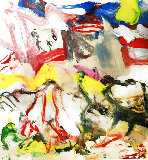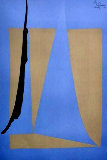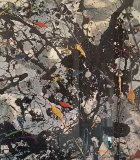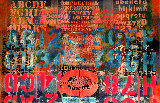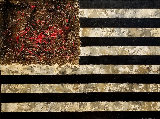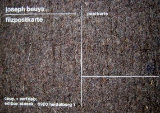-

-
Anselm Kiefer
GermanyArt Brokerage: Anselm Kiefer German Painter: b. 1945. Anselm Kiefer (born March 8, 1945) is a German painter and sculptor. He studied with Joseph Beuys and Peter Dreher during the 1970s. His works incorporate materials such as straw, ash, clay, lead, and shellac. The poems of Paul Celan have played a role in developing Kiefer's themes of German history and the horror of the Holocaust, as have the spiritual concepts of Kabbalah. In his entire body of work, Kiefer argues with the past and addresses taboo and controversial issues from recent history. Themes from Nazi rule are particularly reflected in his work; for instance, the painting "Margarethe" (oil and straw on canvas) was inspired by Paul Celan's well-known poem "Todesfuge" ("Death Fugue"). His works are characterised by an unflinching willingness to confront his culture's dark past, and unrealized potential, in works that are often done on a large, confrontational scale well suited to the subjects. It is also characteristic of his work to find signatures and/or names of people of historical importance, legendary figures or places particularly pregnant with history. All of these are encoded sigils through which Kiefer seeks to process the past; this has resulted in his work being linked with a style called New Symbolism. Kiefer began his career as a photographer with performances in which he, in paramilitary costumes, mimicked the Nazi salute on various locations in France, Switzerland and Italy calling for Germans to remember and to acknowledge the loss to their culture through the mad xenophobia of the Third Reich. In 1969, at Galerie am Kaiserplatz, Karlsruhe, he presented his first single exhibition "Besetzungen (Occupations)" with a series of photographs about controversial political actions. Kiefer is best known for his paintings, which have grown increasingly large in scale with additions of lead, broken glass, and dried flowers or plants, resulting in encrusted surfaces and thick layers of impasto. By 1970, while studying informally under Joseph Beuys at Kunstakademie Düsseldorf, his stylistic leanings resembled Georg Baselitz's approach. He worked with glass, straw, wood and plant parts. The use of these materials meant that his art works became temporary and fragile, as Kiefer himself is well aware; he also wanted to showcase the materials in such a way that they were not disguised and could be represented in their natural form. The fragility of his work contrasts with the stark subject matter in his paintings. This use of familiar materials to express ideas was influenced by Beuys's art practice, in which he used fat and carpet felt. It is also typical of the Neo-Expressionist style. After many years away, Kiefer returned in 1971 to live and work in Donaueschingen. In the years that followed, he incorporated German mythology in particular in his work, and in the next decade he argued with the Kabbalah. He went on extended journeys throughout Europe, the USA and the Middle East; the latter two journeys further influenced his work. Besides paintings, Kiefer created sculptures, watercolors, woodcuts, and photographs. Listings wanted by Art Brokerage.
Read More + - Create Listing 0 Artworks for sale 7 Followers
-
We are actively seeking listings for Anselm Kiefer.
Create a free listing or free wanted ad.







